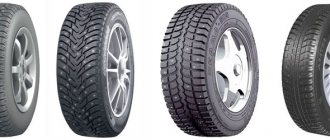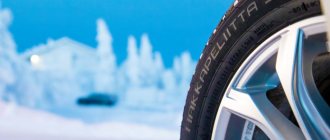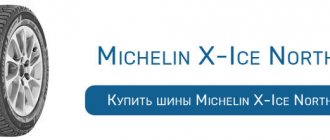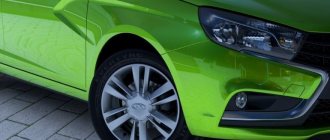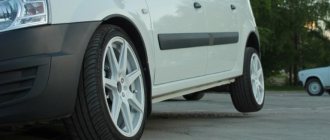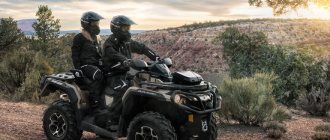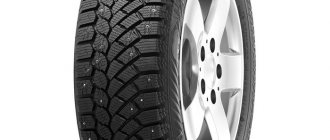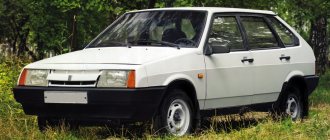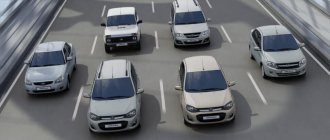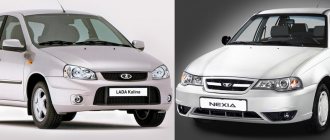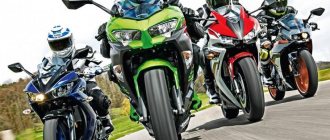This is an age-old dilemma for many.
We conducted a large data analysis, collecting information with test results and expert opinions, supported them with reviews from real users, and compiled the top R18 winter tires for 2021 in terms of price/quality ratio.
It contains only the best models that meet quality and safety requirements, provide excellent control over the road in any weather and comfortable driving.
Rating of the TOP 15 best winter tires R18 2021
| Place | Name | Price |
| TOP 3 best R18 winter tires by price/quality for 2021 | ||
| 1 | MICHELIN X-Ice Snow | Find out the price |
| 2 | Nokian Tires Hakkapeliitta 8 SUV 265/60 R18 114T | Find out the price |
| 3 | Pirelli Ice Zero 235/60 R18 107H | Find out the price |
| TOP 3 best winter tires R18 profile width 225 | ||
| 1 | Nokian Tires Nordman 7 SUV 225/55 R18 102T | Find out the price |
| 2 | MICHELIN X-Ice North 4 225/55 R18 102T | Find out the price |
| 3 | Pirelli Ice Zero 255/55 R18 109H | Find out the price |
| TOP 3 best winter tires R18 profile width 235 | ||
| 1 | Continental ContiViking Contact 7 235/55 R18 104T | Find out the price |
| 2 | MICHELIN X-Ice Snow 235/45 R18 98H | Find out the price |
| 3 | Gislaved Nord Frost 200 SUV 235/55 R18 104T | Find out the price |
| TOP 3 best winter tires R18 profile width 245 | ||
| 1 | Pirelli Ice Zero FR 245/45 R18 100H | Find out the price |
| 2 | Gislaved Nord Frost 200 245/50 R18 104T | Find out the price |
| 3 | MICHELIN X-Ice North 4 245/45 R18 100T | Find out the price |
| TOP 3 best winter tires R18 | ||
| 1 | Gislaved Nord Frost 200 SUV 285/60 R18 116T | Find out the price |
| 2 | Nokian Tires Nordman RS2 SUV 225/55 R18 102R | Find out the price |
| 3 | Pirelli Ice Zero 255/55 R18 109H | Find out the price |
Arvidsyaur — Tolyatti
As usual, we divided the tests into two parts. “White” tests (on snow and ice) were performed at the Continental test site in northern Sweden at the end of January, and “black” tests (on asphalt) at the end of April at the AVTOVAZ test site near Tolyatti.
In winter disciplines, the tire carrier was the Volkswagen Tiguan, and in the asphalt disciplines, the Renault Kaptur was appointed. Both are front-wheel drive. On such cars it is easier to catch the difference in the characteristics of the tires, because the self-activated all-wheel drive lubricates it.
Continental's winter training ground is located in the municipality of Arvidsjaur (Norrbotten province), located 110 kilometers south of the Arctic Circle, almost in the center of Swedish Lapland. Its capital is also called - a small northern town on the shores of the lake of the same name.
The north greeted us with snow sparkling in the sun and light frost. At night the thermometer dropped to -14 °C, and during the day it rose to minus seven.
How to choose R18 winter tires?
To choose the right winter tires for your car, you should not blindly believe the manufacturers’ advertising statements. You need to pay attention to a number of important factors that will help you avoid making mistakes when purchasing.
Climatic conditions
Before purchasing, you should carefully read the information from the manufacturer about what climatic conditions a particular model is designed for.
For the southern and northern regions, different compounds and technologies are used for the production of tires, since they must cope with completely different tasks on the road.
terms of Use
If your main vehicle travel is on city roads, you should take a closer look at friction tires. They are simply designed to move on asphalt and snowy roads.
If you often drive a car on country roads that are icy and compacted, then you should opt for studded models..
Tire size
It is better not to experiment with the height or width of the tire and follow the recommendations of the car manufacturer.
date of manufacture
It is not recommended to buy tires that were produced a couple of years ago and have been lying in the seller’s warehouse all this time. Rubber compounds lose their elasticity during long-term storage, as a result of which the tires cope with the assigned tasks worse.
Purchase budget
You shouldn't save much when buying winter tires. Models that are too cheap may be of poor quality and cannot withstand the load on a winter road.
It doesn’t hurt to read customer reviews of different tire models and choose the best option in terms of price and quality ratio..
Pirelli Scorpion Winter - the dark horse of the tire rating
Rarely does this model appear in reviews as a rating leader, but in terms of its qualities and properties, the tires are quite worthy and can take a certain interesting place in the TOP leaders. In fact, all Pirelli products inspire a certain confidence and can be considered as a really good alternative to other tires. However, Pirelli Scorpion Winter has a whole galaxy of fans among automotive athletes and experts. It’s just that these tires have never been tested on a par with the best-selling tires; they are produced in a small series and are not particularly advertised. But this does not prevent tires from showing such important characteristics:
- directional tread pattern creates a complete feeling of vehicle control on any road;
- the absence of spikes does not prevent the rubber from clinging well to ice and other winter obstacles on the road;
- snowy roads will also not frighten the owner of a crossover equipped with Scorpion tires;
- Among the positive qualities we can note the durability of the tire, low wear of the tread;
- the chemical composition of rubber is universal, tires can be used at above-zero temperatures or in extreme frost;
- passing sharp turns allows you to get rid of most standard winter troubles without problems.
Pirelli has long been one of the important competitors in the automotive tire market. But tires gained real popularity only with the popularization of motor sports. It was participation in various rallies and competitions that allowed the corporation to create a name for itself, which is why in the buyer’s perception this brand name is associated with sports. Scorpion Winter allows you to go on any winter trip without any problems and gain complete confidence in the quality of control and the safety of your car. These tires are designed for various winter conditions of use; they can be purchased both for city use and for traveling on moderate off-road conditions or on highways.
Which company should you choose?
To ensure comfortable and safe driving in winter, you should give preference to popular, trusted manufacturers who value their reputation and exercise strict control over the quality of the goods they produce. They use modern developments and innovative rubber compounds.
These include:
- Nokian;
- Michelin;
- Continental;
- Cordiant;
- Pirelli
- Yokohama;
- Bridgestone;
- Dunlop.
There is no need to waste time on tires from little-known Chinese manufacturers . You should be careful when choosing models from young domestic and Asian companies, as there is a high probability of buying a defective or low-quality product.
Let's sum it up
High-quality tires for crossovers and SUVs are quite an expensive purchase. It is for this reason that it is better to make an informed choice than to buy the first tire you come across and regret a rash purchase for a long time. Today, a high-quality ride on winter roads is only possible with the use of good tires. If the braking distance on your car is much longer than on other cars, serious troubles with your trip may arise. However, it is worth thinking about the price, because some manufacturers offer simply fabulous price tags for their products.
Reviews, ratings and various consultations with specialists will help you find the golden mean. With this kind of information, it's easy to eliminate unworthy options that don't offer a decent winter travel experience. Appreciate the reliability and quality of winter tires, because this is one of the most important parts of preparing a car for use in the cold season. Which winter tires for your car will you prefer?
Intermediate competition on asphalt
Here Gislaved took the lead - the asphalt conqueror did all the “dirty” work perfectly. In second place is Yokohama, just slightly behind Gislaved due to minor comments regarding directional stability. The third result was shown by Goodyear - grip was above average, but directional stability was disappointing. Continental had almost the same result (the difference is only one tenth of the final score). Fifth place goes to Nordman tires: they were ahead of everyone in terms of directional stability, but failed in braking on wet roads. Nokian is a little worse - it blew away during dry braking. Michelin is at the tail of the column: it can only boast of directional stability. The most recent one is Nexen. Frankly weak, there’s nothing even to praise him for.
We didn't wait!
In the “white” classification, Nokian wins, Continenal takes second place, and Yokohama confidently climbs to third place. Amazing! Not a single measurement result is below average, not a single expert rating below seven. And in terms of cross-country ability, Yokohama is not only ahead of such giants as Continental, Michelin and Nokian, but also close on the heels of the unsurpassed “all-terrain vehicle” Goodyear. I wonder how these tires will perform on asphalt?
Nordman, Goodyear and Gislaved follow in a tight group. Goodyear is aging - it is already supported by second-tier tires. Michelin also looks pale. Maybe it will even win back in the “black” tests?
Nexen is trailing behind everyone by a wide margin. The loss on ice can still be explained by the insufficient protrusion of the spikes, but on the snow it’s also not at all “ice”! Last places in all exercises. The only exceptions are directional stability on snow (at the level of the Continental) and the handling characteristics of Goodyear during active driving.
Creative in the snow
We again drive out to the large snow plateau where we took measurements. Now we need to evaluate directional stability at a speed of 100 km/h, the behavior of the car during a sudden lane change at speeds from 40 to 60 km/h, as well as cross-country ability in deep snow.
There were no outright weaklings: the lowest score was seven points. Great! This means that modern winter tires are getting better and better. And yet, Goodyear, Michelin, Nokian and Nordman hold the line more reliably than others.
Detour of an obstacle with a lane change, that is, a rearrangement, is carried out on a snowy surface. The car behaves exemplarily on Nokian tires, demonstrating a soft, easily removable skid in the second phase of the exercise (after shifting the steering wheel). A completely different picture emerges with Gislaved, Goodyear and Nexen tires: the Tiguan shod in them goes into a progressive skid, requiring instant correction from the driver. If you don’t have time to extinguish it in the initial phase, the car will turn around.
Cross-country ability is an important characteristic of tires not only for our outback, but also for megacities, whose roads often remain uncleaned for some time after heavy snowfall. In deep snow, the real king is Goodyear: these tires can handle any snowdrifts. Nexen likes deep snow least of all: movement is only under tension, excluding any slipping. The car, shod with Nexen, drives uncertainly both forward and backward, and is reluctant to maneuver.
Meticulous measurements
To evaluate traction on ice and snow, we traditionally perform five exercises. We always start acceleration from a standstill, since at the moment of start some tires slip and “hang”. The upper measurement limit on snow is 40 km/h, on ice – 20 km/h. We measure the braking distance from the same speeds up to 5 km/h.
On each set of tires we repeat the measurements 10-12 times, and after two or three sets we check the condition of the coating, changing the car to a set of base tires, which in foreign words are called reference tires, but in our language - “stove”. All measurements are carried out using the VBOX measuring system, popular among tire manufacturers, based on GPS data.
On ice, the best acceleration (4.2 s) is provided by Nokian, Nordman and Yokohama, the most modest grip is provided by Nexen - its time is almost one and a half times worse than that of the leaders. And the car brakes best on Nokian tires (7.1 m). Their closest rivals, Continental and Yokohama, are half a meter, or 7%, behind. Behind everyone is Nexen: a car with these tires increases the braking distance by 40% compared to the best result!
The time taken to complete an ice circle characterizes the lateral grip of the tires. Here Continental distinguished itself together with the representative of the junior brand Gislaved. Nexen turned out to be the slowest - its result is almost 12% worse.
In acceleration on snow, the Continental won, and the Nexen was almost 20% behind. The leading results in braking are achieved by Gislaved and Nokian tires. Continental and Michelin gave them just a little - 0.2 meters. Behind everyone again is Nexen with a 15 percent lag.
Tops fell asleep on the asphalt
Let us remind you that we carry out asphalt tests at the AVTOVAZ test site at the end of April, before the air temperature rises above 8 °C. The carrier is another popular crossover on our market - Renault Kaptur.
The first stage is an instrumental assessment of efficiency, combined with an expert assessment of directional stability and comfort. We start with races on the expressway at a speed of 130 km/h, and end on service roads with classic Russian cracks and gouges, without which it would be incorrect to evaluate the noise and smoothness of the ride in our conditions.
Nokian wins the title of leader in efficiency both at 90 km/h and at 60 km/h. The outsider turns out to be Nexen, which requires 300 cc more for every 100 km of travel, and in both speed modes.
Experts gave the highest ratings for directional stability to Gislaved, Nordman and Michelin tires. On them, Kaptur not only holds a straight line well, but also demonstrates clear reactions and error-free behavior when adjusting the direction of movement and soft lane changes. Renault performed worst on Goodyear tires. When adjusting the direction, testers noted delays in reactions, large steering angles and a tendency for the rear axle to steer, which could provoke a skid.
